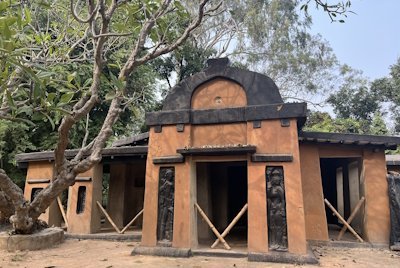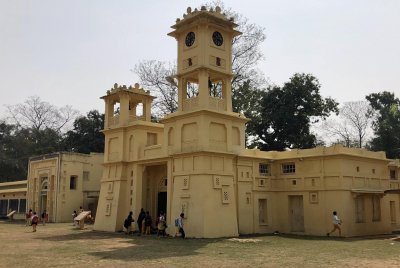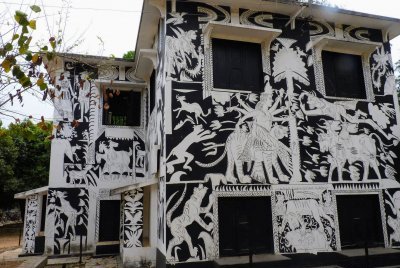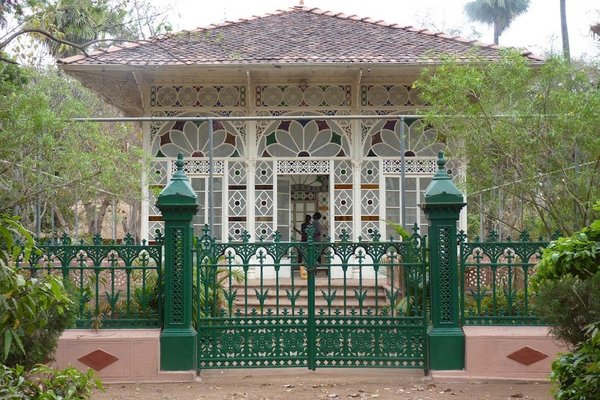India
Santiniketan
Santineketan is a holistic educational institution founded by the poet and philosopher Rabindranath Tagore based on a utopian ideal.
The experimental settlement from the early 20th century had a rural setting. It offered a broad spectrum of classes in arts, language, humanities, crafts, and music, embracing many cultures and religions. The buildings were designed in an eclectic style, moving away from colonial architecture. The site is also strongly associated with Tagore's work and holds a collection of his manuscripts.
Community Perspective: Solivagant reviewed this site over a decade ago, and he explains its values and nomination history. Stanislaw provides a current overview of its accessibility, including a step-by-step guide on how to get into the University Complex as it is normally closed off to tourists. Els warns about limited opening hours: Monday, Tuesday and Friday seem to be the best days.
Site Info
Official Information
- Full Name
- Santiniketan (ID: 1375)
- Country
- India
- Status
-
Inscribed 2023
Site history
History of Santiniketan
- 2023: Inscribed
- Inscribed
- 2011: Requested by State Party to not be examined
- Type
- Cultural
- Criteria
- iv
- vi
Links
- UNESCO
- whc.unesco.org
- Official
-
- wbtourism.gov.in — West Bengal Tourism website
- Related
-
- santiniketan.com — Santiniketan.com provides background info
All Links
UNESCO.org
- whc.unesco.org — whc.unesco.org/
Official Website
- wbtourism.gov.in — West Bengal Tourism website
Related Resources
- santiniketan.com — Santiniketan.com provides background info
News Article
- Oct. 22, 2023 hindustantimes.com — Row over Tagore’s name missing on Santiniketan’s Unesco tag plaques
Community Information
- Community Category
- Secular structure: Science and Education
Travel Information
Recent Connections
-
Works by Nobel Prize winning authors
The Shantiniketan School song by Rabind… -
Literature
"many of Tagore’s art and literary wor… -
Foreigner prices
Foreigners pay 100 rs, Indians 20.
Connections of Santiniketan
- Individual People
-
-
Mahatma Gandhi
Gandhi visited Tagore's school and university in Santiniketan on four occasionsSee www.mkgandhi.org
-
- Architecture
-
-
Earth Architecture
"The Uttarayan area was established to the north of the Ashrama from 1919 with the construction of two mud brick buildings (one of which, Konark, still stands), followed by five additional houses for Rabindranath Tagore. These show various experiments with the thermal performance of mud buildings" (AB ev) -
Gesamtkunstwerk
"Santiniketan was an experimental settlement in education and communal life in a rural setting. The community was in many ways meant to represent a uniquely Indian example of a 'total work of art' (Gesamtkunstwerk) where life, learning, work and art along with the local and the global intertwined seamlessly." (Official description) -
Art Deco
"It was consciously international in its outlook, with aesthetic and philosophical influences from .. Art Deco" (AB ev) -
Reinforced Concrete
"There are examples of lowlevel reinforced concrete buildings," (AB ev)
-
- Human Activity
-
-
Festivals
"The largest and most notable fair is the Poush Mela held at Santiniketan for three days from 7 Poush.[33] Devendranath Tagore with twenty followers accepted the Brahmo creed from Ram Chandra Vidyabagish on 21 December 1843 (7 Poush 1250 according to the Bengali calendar). This was the basis of Poush Utsav (the Festival of Poush) at Santiniketan" (wiki)
-
- Timeline
-
-
Built in the 20th century
"In 1901, Rabindranath Tagore began its transformation to a residential school and centre for art" (AB ev)
-
- Science and Technology
-
-
Universities
"Santiniketan developed into a pan- Indian University, due to the diversity of its teachers and its subjects." (AB ev)
-
- Visiting conditions
-
-
Foreigner prices
Foreigners pay 100 rs, Indians 20.
-
- Literature & Film
-
-
Works by Nobel Prize winning authors
The Shantiniketan School song by Rabindranath Tagore (NP winner 1913). -
Literature
"many of Tagore’s art and literary works bear a unique association with Santiniketan" (crit vi)
-
News
- hindustantimes.com 10/22/2023
- Row over Tagore’s name missing on …
Community Reviews
Show full reviews
Just a short update on Santiniketan from me, as the previous two reviewers already have covered it well. The site fails so many of the WHS Commandments at the moment that a visit is a poor investment of time and money. On paper, I can see there is “something” worth acknowledging but in reality, I don’t know what message they are trying to convey to the world. Or whether they care about outside visitors at all. The place is run by a kind of ‘Education Trust’, which already worried ICOMOS, as it plays by its own rules.
The most interesting things to see are the quirky buildings, which could be labelled as ‘modernist vernacular’. Here again, I have to concur with ICOMOS in its evaluation: they aren’t notable from an architectural perspective, you have to consider them as part of the overall idea of an early 20th-century utopian university community in a rural setting.
Some practical things to keep in mind:
- As described in detail by Stanislaw, the Visva-Bharati Campus is now firmly closed to outsiders, even with signs “Tourists not allowed”. Thus you will miss out on some of the highlights such as the Kala Bhavan (Art School) with the tarred Kalo Bari, unless you are prepared to go through all the hoops of acquiring permission and are lucky enough to get it.
- The foreigners’ entrance fee to the Rabindra Bhavana (Tagore museum) has risen to a ridiculous 1,000 rs (ca. 11.5 EUR). …

Visited February 2024
Visit easily doable as a day trip starting in the morning around 7am from Sealdah train station in Kolkata, taking a train to the station named Bolpur Shantiniketan [in Bangla language they pronounce Shantiniketan instead of Santiniketan in Hindi] (the trip takes around 3 hours but could be much longer because Indian trains are unpredictable… I was lucky enough – trains to and from Bolpur had only minimal delays 😊).
Arriving in Bolpur Shantiniketan you can take an auto rickshaw or walk for around 2km and a half to Shantiniketan Campus; and keep in mind that it is not so simple to get into the campus of the Visva-Bharati while you’re there… The property is quite big and there are many gates and paths leading to its historical buildings and bhavans but at each entrance (yes!) there are guards (many of them walking around too) who won’t let you get into the premises of the university without a written permission! Why? Because this is a school, there are students at different age – from primary school children to art and literature students; and walking while they have classes sometimes under the trees (this tradition is still alive) can really disturb them, especially the younger ones… I understand that… That’s during the week and during the weekends… I was told the complex is closed and still no access to most of the buildings.
Is there anything you can see/visit without it? Yes, Rabindra Bhavana, museum …
Keep reading 0 comments
Shantiniketan (a.k.a "Santiniketan") is another Indian site which is having problems getting inscribed (Nominated for 2011 but withdrawn). Its credentials as the location where the Bengali poet, artist, philosopher and polymath Rabindranath Tagore put his ideas into action suggested that it might be worth looking at, both in its own right and in pursuance of my Indian T List quest! It is located 160 kms North West of Kolkata and is feasible as a day return trip from there. In Feb 2013 we took the "Shantiniketan Express" (sic) out, leaving Howrah at 10.10 and arriving at 12.25 and returned on the 17.38 arriving back at 20.15. The train goes to Bolpur which is only a 3km rickshaw ride from the site.
Tagore (1861 -1941) is a Bengali, and by transference, an Indian, national hero. In 1913 he became the first "non-European” to win the Nobel prize for literature (or, apart from T Roosevelt, any Nobel prize at that time ). Interestingly. this was for his own English translation of a collection of his poems written in Bengali which is generally considered significantly less good than the original!! He was later knighted but returned this honour in protest over the Amritsar massacre. In the following years he became an internationally acclaimed figure who, whilst traveling the World, met with all the great and good of the era so there are reams of photos of him meeting Einstein, GB Shaw, Helen Keller etc etc. He is credited …
Keep reading 0 comments
